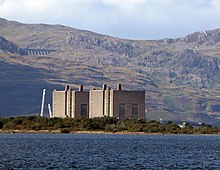Trawsfynydd nuclear power station
| Trawsfynydd nuclear power station | |
|---|---|
 |
|
| Country | Wales, United Kingdom |
| Location | Trawsfynydd, Gwynedd |
| Coordinates | 52°55′29.51″N 3°56′54.38″W / 52.9248639°N 3.9484389°WCoordinates: 52°55′29.51″N 3°56′54.38″W / 52.9248639°N 3.9484389°W |
| Status | Closed |
| Construction began | 1959 |
| Commission date | 1965 |
| Decommission date | 1991 |
| Construction cost | £103 million |
| Owner(s) | Nuclear Decommissioning Authority |
| Operator(s) | Magnox Ltd |
| Nuclear power station | |
| Reactor type | Magnox |
| Reactor supplier | Atomic Power Constructions |
| Power generation | |
| Units decommissioned | 2 x 235 MW |
Trawsfynydd nuclear power station is a disused Magnox power station situated on the north shore of Llyn Trawsfynydd in Gwynedd, Wales. It is significant for being the only Nuclear power station in the UK which was not built on the coast; the plant drew water instead from the nearby lake.
The power station was designed by Basil Spence. The construction, which was undertaken by a consortium involving Crompton Parkinson, International Combustion, Fairey Engineering and Richardsons Westgarth, and known as the Atomic Power Constructions (APC), began in July 1959, and both of the reactors were in operation by March 1965, with the station opening fully in October 1968, at a cost of £103 million. It had two Magnox reactors producing 470 megawatts (MW) in total. The reactors were supplied by APC and the turbines by Richardsons Westgarth. The civil engineering work was undertaken by Holland, Hannen & Cubitts and Trollope & Colls. The architectural consultant for the buildings was Sir Basil Spence and the landscape architect was Sylvia Crowe.
Both have been shut down since 1991; the site is in the process of being decommissioned by the Nuclear Decommissioning Authority.
The Bala to Blaenau Ffestiniog railway line had closed completely in January 1961, but its tracks and infrastructure had been mothballed against the possibility of freight or military traffic resuming. The line had a siding approximately half a mile west of the power station. In 1963-4 a "Goliath" gantry crane was installed over the siding. A single track was restored northwards and a wholly new connection was laid in the centre of Blaenau Ffestiniog between the restored line and the extant Conwy Valley Line. This allowed nuclear flasks to be sent and received by rail to destinations such as Sellafield.
...
Wikipedia

